The infertility treatment market is witnessing significant growth driven by rising infertility rates globally and increasing awareness about available treatment options. The market outlook is shaped by advancements in reproductive technologies, greater accessibility of fertility clinics, and changing societal dynamics that delay parenthood. Growing prevalence of lifestyle disorders, stress, and hormonal imbalances has contributed to a higher incidence of infertility, thereby fueling demand for effective treatments.
Technological innovations in assisted reproduction, cryopreservation, and genetic screening have enhanced success rates, boosting patient confidence and encouraging adoption. Additionally, supportive government initiatives, insurance coverage for fertility procedures, and growing medical tourism are further stimulating market expansion.
Increased investments in healthcare infrastructure and research aimed at improving reproductive health outcomes continue to strengthen market prospects The future growth trajectory is expected to remain positive as the integration of AI-based diagnostics, personalized medicine, and non-invasive reproductive technologies gains momentum across both developed and emerging economies.
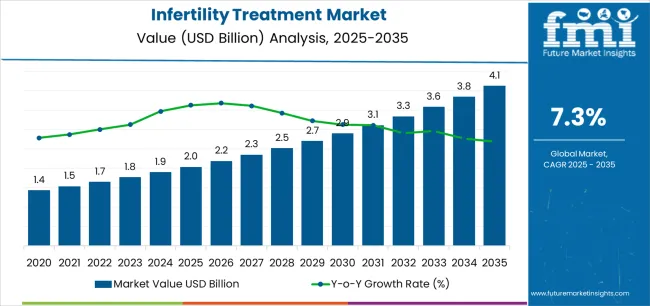
| Metric | Value |
|---|---|
| Infertility Treatment Market Estimated Value in (2025 E) | USD 2.0 billion |
| Infertility Treatment Market Forecast Value in (2035 F) | USD 4.1 billion |
| Forecast CAGR (2025 to 2035) | 7.3% |
The market is segmented by Product, Procedure, Patient Type, and End User and region. By Product, the market is divided into Media & Consumables, Equipment, and Accessories. In terms of Procedure, the market is classified into Assisted Reproductive Technology, Artificial Insemination, Fertility Surgeries, and Other Infertility Treatment Procedures. Based on Patient Type, the market is segmented into Female Infertility Treatment and Male Infertility Treatment. By End User, the market is divided into Fertility Centres, Hospitals & Surgical Clinics, Cryobanks, and Research Institutes. Regionally, the market is classified into North America, Latin America, Western Europe, Eastern Europe, Balkan & Baltic Countries, Russia & Belarus, Central Asia, East Asia, South Asia & Pacific, and the Middle East & Africa.
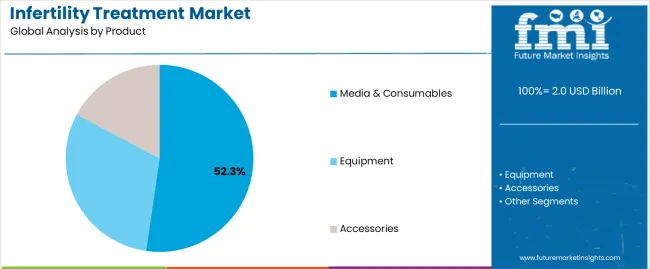
The media and consumables segment is projected to hold 52.30% of the infertility treatment market revenue share in 2025, making it the leading product category. The dominance of this segment is attributed to its essential role in in-vitro fertilization and other assisted reproductive procedures, where the use of high-quality culture media and laboratory consumables is critical for embryo development and fertilization success.
Increased focus on precision and consistency in fertility outcomes has driven the demand for specialized consumables designed to maintain optimal culture conditions. The growing number of fertility clinics and higher patient throughput rates have also contributed to the sustained consumption of these products.
Furthermore, advancements in cell culture technologies, continuous quality improvements, and the introduction of ready-to-use consumables have streamlined laboratory workflows The ongoing emphasis on safety, traceability, and regulatory compliance has reinforced the use of certified and standardized consumables, positioning this segment as a cornerstone of infertility treatment processes.
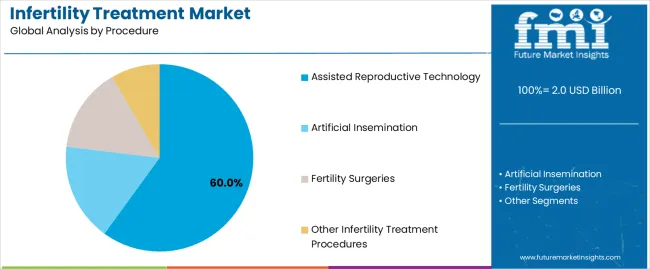
The assisted reproductive technology segment is expected to account for 60.00% of the infertility treatment market revenue share in 2025, making it the dominant procedure type. Growth in this segment has been driven by increasing adoption of advanced reproductive procedures such as in-vitro fertilization, intracytoplasmic sperm injection, and embryo cryopreservation. Continuous technological advancements improving embryo selection, implantation rates, and overall treatment efficacy have strengthened this segment’s prominence.
Rising awareness of ART success rates among couples and supportive regulatory frameworks in several countries have enhanced accessibility to these procedures. Furthermore, delayed family planning, higher incidences of male and female infertility, and evolving social acceptance of fertility treatments are accelerating demand.
The integration of digital monitoring systems, automation, and precision diagnostics has optimized ART processes, ensuring better patient outcomes As the focus on success predictability and patient-centered care increases, the assisted reproductive technology segment is expected to maintain its leading position in the infertility treatment landscape.
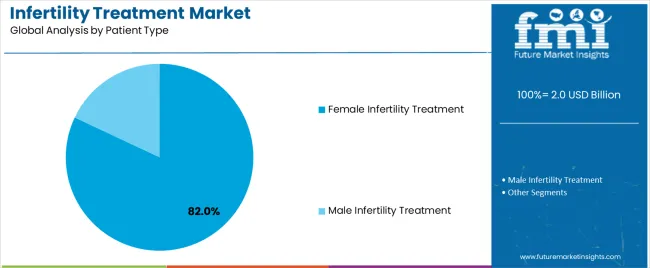
The female infertility treatment segment is anticipated to capture 82.00% of the infertility treatment market revenue share in 2025, underscoring its significant dominance. The high share of this segment is driven by the greater prevalence of fertility complications among women due to factors such as hormonal disorders, polycystic ovary syndrome, endometriosis, and advanced maternal age. Increased awareness and proactive medical consultations among women seeking fertility assistance have supported higher treatment adoption.
The availability of multiple therapeutic and procedural options tailored specifically for female reproductive health has further boosted this segment. Continuous improvements in diagnostic accuracy and the development of minimally invasive techniques have contributed to higher success rates in female infertility treatment.
In addition, favorable healthcare policies, insurance reimbursements, and the increasing presence of specialized fertility centers have strengthened patient accessibility As societal attitudes evolve and technological progress continues, female infertility treatments are expected to remain central to the market’s growth trajectory.
The table below compares the compound annual growth rate (CAGR) for the global infertility treatment industry from 2025 to 2025 during the first half of the year. This overview highlights key changes and trends in revenue growth, offering valuable insights into industry dynamics.
H1 covers January to June, while H2 spans July to December. In the first half (H1) of the decade from 2025 to 2035, the business is predicted to surge at a CAGR of 8.4%, followed by a slightly lower growth rate of 8.0% in the second half (H2) of the same decade.
| Particular | Value CAGR |
|---|---|
| H1 | 8.4% (2025 to 2035) |
| H2 | 8.0% (2025 to 2035) |
| H1 | 7.3% (2025 to 2035) |
| H2 | 6.9% (2025 to 2035) |
Moving into the subsequent period, from H1 2025 to H2 2035, the CAGR is projected to decrease slightly to 7.3% in the first half and remain relatively moderate at 6.9% in the second half. In the first half (H1) the industry witnessed a decrease of 110 BPS while in the second half (H2), the industry witnessed a decrease of 110 BPS.
Rise in infertility cases due to disorders such as PCOS driving the market growth
PCOS is the most common factor for hormonal disorders in childbearing women, resulting in infertility due to irregular menstrual cycle and obesity, by raising excessive androgen levels in the body. As the incidence of PCOS increases in women, healthcare professionals are promoted to work on medicines and assisted reproductive techniques to cure infertility caused by PCOS.
Increased awareness about PCOS goes hand in hand with demands to treat it more efficiently so that women can manage their symptoms and boost their fertility potential. The rising health awareness among females is creating a social trend wherein they are seeking help for their reproductive problems and hence demand for infertility treatment.
As healthcare systems evolve to simply meet this ever-increasing demand, new opportunities in the marketplace for PCOS-related infertility treatments will also increase for patients and health providers alike, looking to achieve improved reproductive health outcomes.
For instance, according to an article published in Cureus, an open-access medical journal, in August 2025, there are around 116 million women currently suffering from PCOS globally.
Thus, increasing prevalence of PCOS would eventually lead to rise in infertility. This is expected to increase the demand for proper treatment for infertility among women, which drives the market growth.
Technological advancements in infertility treatment creates a window of opportunity
Technological advancements have significantly improved the success rate of treatments and increased the number of patients seeking treatment. Improved imaging systems and time-lapse technologies changed the face of fertility treatment administration.
Time-lapse imaging, for instance, enhances the ability to monitor embryo development continuously without removing it from the incubator, which enables embryologists to select the most viable embryos based on their growth pattern. This kind of accuracy in the selection of the embryo would also increase the chances of proper implantation and pregnancy.
Genetic diagnosis was the next step forward, where Preimplantation Genetic Testing made even the identification of genetic abnormalities in embryos possible before implantation and reduced the incidence of hereditary disorders, therefore improving success rates overall.
Artificial intelligence dramatically affects fertility treatment because it makes a deep analysis of large reams of data to provide individual treatment recommendations that help in optimizing protocols for better outcomes. Second, improvements in cryopreservation techniques have very much helped to preserve embryos and ovarian tissue, hence giving patients a chance to plan the treatments better.
In the future also, these technologies will continue to evolve, improving the effectiveness of treatments for infertility and empowering individuals and couples to seek assistance on their journey to parenthood.
Shift toward personalized infertility treatments is a major trend in this market
Tailoring the approaches to the needs of different patients makes it more effective and raises patient satisfaction since it acknowledges that infertility can result from age, lifestyle, and underlying diseases. Advanced diagnostics, with genetic testing and biomarker screenings at their head, help design targeted treatment plans that suit the specific causes of infertility in a given patient.
Targeted therapies may involve tailored doses of medication, the best selection of appropriate assisted reproductive technology, or the best timing of procedures based on a patient's individualized biological markers. For instance, the use of endometrial receptivity arrays can help identify the ideal window for embryo implantation, increasing the chances of a successful pregnancy.
As understanding of infertility deepens, further support for personalized care is created with the integration of technologies such as artificial intelligence, which further supports personalized care by analysis of patient data to optimize treatment protocols. The trend enhances clinical outcomes and the feeling of empowerment by the patient with involvement in the treatment journey.
High cost of infertility treatment devices may Restrict Infertility Treatment Market Growth
High treatment costs using assisted reproductive technologies (ART) are a major restraint to market growth. Procedures under ART, such as in vitro fertilization, also known as IVF, may run into a significant amount for a couple, up to USD 15,000 to USD 30,000 per cycle in the USA These high costs can limit access to treatment and lead to financial hardship for those seeking to conceive.
Most of the advanced devices and procedures in infertility assistances are very expensive; hence, a good number of populations cannot access these services. This makes a section of the population shun away from seeking treatment due to the high costs involved, or they may lead to strained finances for those who may seek services.
The high costs of ART are also attributed to the complexity of the procedures involved, the specialization of the equipment and facilities, as well as the vast team of health professionals involved.
In this respect, ART is not covered by insurance or state-run programs for many countries, leaving the entire burden to patient’s pockets and, therefore, out of reach for many. This could mean that fewer numbers can afford the necessary treatment, hence a retardation of the market generally speaking.
The global infertility treatment industry recorded a CAGR of 6.6% during the historical period between 2020 and 2025. The growth of infertility treatment industry was positive as it reached a value of USD 3,843.3 million in 2035 from USD 1,899.8 million in 2025.
Historically, there has been a stigma associated with the treatment of infertility that has LED to a great amount of social isolation for many individuals. In years gone by, most cultures looked at infertility as a personal failure, mainly laying blame on the woman, hence keeping her from coming forward to seek medical assistance.
Such lack of awareness about infertility as a medical condition rendered access to effective treatments difficult, hence sustaining myths and misconceptions. For example, development in medical science over time has begun to break such cultural perceptions by providing more understanding about infertility and its treatment.
Several factors contribute to growing the infertility treatment market. First, the decline in fertility rates worldwide, mostly due to late marriages and age-related infertility cases, increases the demand for treatment methods. With the trend of couples delaying starting families for personal or professional reasons, the need for assisted reproductive technologies increased many-fold.
Another reason contributing to this increase is the rising cases of infertility conditions, such as PCOS and hormonal disorders that compel more people to seek medical help.
Better infertility treatment options, novel procedures, and better imaging systems have contributed to greater success rates in treatment, thus attracting more patients. Another reason for the growth is increased access to such services, corresponding to the opening of fertility clinics all over the world.
Furthermore, growing awareness and acceptance among people with regard to infertility treatments for same-sex couples and single parents are also on the rise, thereby increasing market size. All these factors are fueling rapid growth in the infertility treatment market, suggestive of a trend toward more comprehensive reproductive health solutions.
Tier 1 companies are the industry leaders as they hold a substantial 28.5% value share worldwide. These companies have generated revenue over USD 100 million. These companies have large product portfolio and a high production capacity. These industry leaders stand out for having a wide geographic reach, and a strong customer base.
They offer a variety of products. Prominent companies within tier 1 include Thermo Fisher Scientific, Cook Group, and CooperSurgical Inc.
Mid-size businesses with annual revenue between USD 50 and USD 100 million and which are capturing a value share of 36.5% in global market, and that are based in particular areas and have a significant impact on the local industry are considered Tier 2 companies. These companies have regional presence and in-depth industry expertise.
These companies also have large product portfolio. However, less as compared with tier 1 players. Prominent companies in tier 2 include AB Scientific Ltd., Vitrolife, IVFtech APS and Hamilton Thorne Ltd.
Tier 3 companies, although, smaller but are essential for the growth of the industry. Compared with tier 1 and tier 2 these companies have limited product portfolio and has lesser revenue. These companies cater to one or two countries. The companies such as Esco Micro Pte Ltd., Genea Biomedx Ltd., FUJIFILM Irvine Scientific, Baker Company INC. and other falls under this category.
They specialize in specific products and cater to niche markets, adding diversity to the industry.
The section below covers the industry analysis for the infertility treatment market for different countries. Market demand analysis on key countries in several regions of the globe, including North America, Latin America, East Asia, South Asia & Pacific, Western Europe, Eastern Europe and Middle East & Africa, is provided.
The United States is anticipated to remain at the forefront in North America, with a value share of 81.6% through 2035. In Asia Pacific, China is projected to witness a CAGR of 7.3% by 2035.
| Countries | Value CAGR (2025 to 2035) |
|---|---|
| USA | 2.3% |
| Germany | 2.3% |
| France | 3.7% |
| UK | 2.6% |
| China | 7.3% |
| India | 8.3% |
| South Korea | 5.7% |
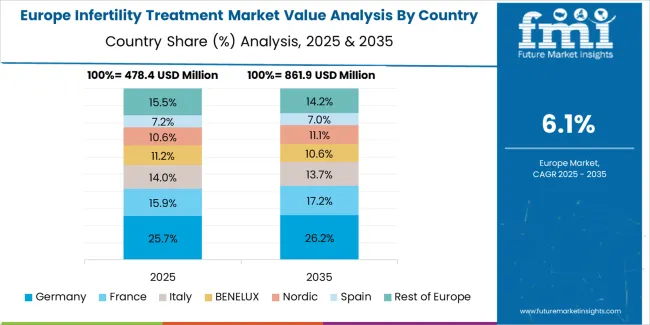
Germany’s infertility treatment market is expected to exhibit a CAGR of 2.3% between 2025 and 2035. The Germany holds highest market share in European market.
The growth in the German infertility treatment market has been contributed by government sponsorship of research projects. Federal and state governments have granted priority to fund scientific research in the field of health care and biotech, which usually has a direct application in new infertility treatment developments.
Reproductive health research is generously funded by the government under various funding programs and strategic measures, such as the Excellence Strategy and the Future Strategy for Research and Innovation, among others.
This financing propels collaboration among academia, research organizations, and private enterprise, thus furthering cutting-edge technologies in assisted reproductive techniques. The commitment to research funding for advancing reproductive health ultimately strengthens Germany's strength in innovation and leadership in infertility treatments.
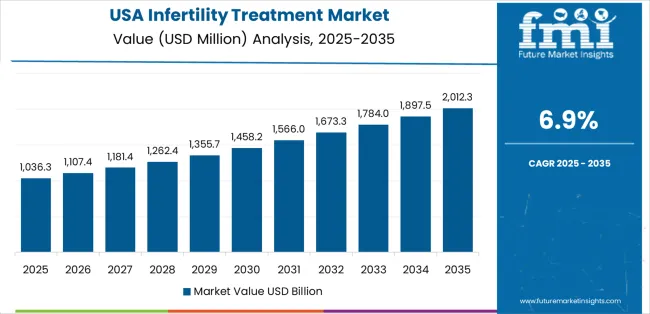
The USA market is anticipated to grow at a CAGR of 2.3% throughout the forecast period.
The growing number of fertility clinics in the USA continues to fuel the market for infertility treatment. The establishment of the facilities throughout the country follows an increased awareness about infertility issues among a large number of individuals and couples, hence creating a demand for specifically concerned treatment services.
A wide range of services is tied to be delivered through these facilities catering to patient needs, including assisted reproductive technologies (ART) like in vitro fertilization (IVF) and intrauterine insemination (IUI).
The growth of fertility clinics increases access to treatments and makes it easier for patients to get in touch for help in case of any need. The rise in developed technology and medical practices through these clinics increases the success rates and makes more and more patients come seeking treatment. The rise in fertility clinics also serves as evidence of the shift in social norms because a greater number of people are signing up for reproductive services.
The China is expected to hold a dominating position in East Asia market of infertility treatment and is anticipated to grow at a CAGR of 7.3% throughout the forecast period.
The country is becoming one of the most preferred destinations in the world for patients in search of high-quality, low-cost fertility treatments. The country possesses leading medical technologies coupled with experienced professionals who seek to target the niche of affordable reproductive technologies among patients like in vitro fertilization technologies.
The government has also backed the medical tourism industry in making healthcare reforms and ensuring that medical zones are set up professionally, thus improving the experience. More awareness of infertility issues all over the world and more acceptance of medical tourism mean that more couples will also consider China for their fertility treatment needs.
This trend expands the market, and China becomes competitive in the global arena of infertility treatment.
The section contains information about the leading segments in the industry. Based on product, the media & consumables is expected to account for 46.6% of the global market share in 2025.
| Product | Media & Consumables |
|---|---|
| Value Share (2025) | 46.6% |
The media & consumables segment is expected to dominate the market in terms of revenue, accounting for almost 46.6% of the market share in 2025. The prime segment to dominate the infertility treatment market is projected to be the media & consumables because, for most consumers, it is easy to obtain and is not too costly.
Moreover, the media and consumable plays a vital role during treatment procedures. Consumables, like hormones and diagnostic kits, are used frequently and require continuous replenishment, driving significant recurring revenue.
Increasing usage of different types of media to culture embryos coupled with the expansion of IVF devices and the consumables market will further boost the growth of this segment. In addition, whenever the in-vitro fertilization is performed there is a need for media & consumables. Moreover, in every facility media & consumables will be consumed more and will generate recurring revenue.
| Procedure | Assisted Reproductive Technology |
|---|---|
| Value Share (2025) | 31.7% |
By procedure, the assisted reproductive technology segment is projected to hold a major market share of 31.7% in 2025.
ART dominates the infertility treatment market for varied reasons. The success rates of such procedures have increased manifold with advances in techniques, especially the method of in vitro fertilization. More adoption and acceptability of ART as an effective means of achieving pregnancy in cases of infertility further add to its dominance.
There is also more significant institutional financial backing and more insurance coverage in many countries towards ART treatments, thus making these services accessible to many people.
The number of fertility clinics and hospitals with advanced ART services has also been growing in both developed and developing areas. All these factors make ART the largest procedure segment of the infertility treatment market, and it is likely to continue in the future.
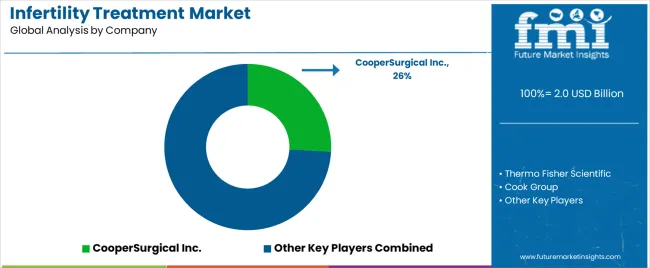
The infertility treatment market is highly fragmented. There are large number infertility treatment manufacturer in the global market involved in developing innovative products so that they can meet their customer’s needs.
Prominent manufacturer of infertility treatment products are focused on growing internationally in order to increase their revenue and increase the size of their sales footprint in developing nations through the purchase of regional competitors. Manufacturers utilize various key strategies such as agreements, product launches, research sponsorship, and strategic collaborations to boost product sales and establish their market presence.
Some of the major player in Infertility Treatment Market includes
In terms of product, the industry is divided into equipment (microscopes, imaging systems, sperm analyser systems, ovum aspiration pumps, micromanipulator systems, incubators, gas analyzers, laser systems, cryosystems, and sperm separation devices), media & consumables and accessories
In terms of procedure, the industry is divided into assisted reproductive technology [in vitro fertilization (intracytoplasmic morphologically selected sperm injection and gamete donation), intracytoplasmic sperm injection, and surrogacy], artificial insemination (intrauterine insemination, intracervical insemination and intratubal insemination), fertility surgeries [laparoscopy, hysteroscopy, varicocelectomy, laparotomy, tubal ligation reversal, microsurgical reconstruction (vasovasostomy and vasoepididymostomy)] and other infertility treatment procedures
In terms of patient type, the industry is segregated into female infertility treatment and male infertility treatment.
In terms of end user, the industry is segregated into fertility centers, hospitals & surgical clinics, cryobanks, and research institutes
Key countries of North America, Latin America, Europe, East Asia, South Asia & Pacific, Middle East and Africa (MEA) have been covered in the report.
The global infertility treatment market is estimated to be valued at USD 2.0 billion in 2025.
The market size for the infertility treatment market is projected to reach USD 4.1 billion by 2035.
The infertility treatment market is expected to grow at a 7.3% CAGR between 2025 and 2035.
The key product types in infertility treatment market are media & consumables, equipment and accessories.
In terms of procedure, assisted reproductive technology segment to command 60.0% share in the infertility treatment market in 2025.






Our Research Products

The "Full Research Suite" delivers actionable market intel, deep dives on markets or technologies, so clients act faster, cut risk, and unlock growth.

The Leaderboard benchmarks and ranks top vendors, classifying them as Established Leaders, Leading Challengers, or Disruptors & Challengers.

Locates where complements amplify value and substitutes erode it, forecasting net impact by horizon

We deliver granular, decision-grade intel: market sizing, 5-year forecasts, pricing, adoption, usage, revenue, and operational KPIs—plus competitor tracking, regulation, and value chains—across 60 countries broadly.

Spot the shifts before they hit your P&L. We track inflection points, adoption curves, pricing moves, and ecosystem plays to show where demand is heading, why it is changing, and what to do next across high-growth markets and disruptive tech

Real-time reads of user behavior. We track shifting priorities, perceptions of today’s and next-gen services, and provider experience, then pace how fast tech moves from trial to adoption, blending buyer, consumer, and channel inputs with social signals (#WhySwitch, #UX).

Partner with our analyst team to build a custom report designed around your business priorities. From analysing market trends to assessing competitors or crafting bespoke datasets, we tailor insights to your needs.
Supplier Intelligence
Discovery & Profiling
Capacity & Footprint
Performance & Risk
Compliance & Governance
Commercial Readiness
Who Supplies Whom
Scorecards & Shortlists
Playbooks & Docs
Category Intelligence
Definition & Scope
Demand & Use Cases
Cost Drivers
Market Structure
Supply Chain Map
Trade & Policy
Operating Norms
Deliverables
Buyer Intelligence
Account Basics
Spend & Scope
Procurement Model
Vendor Requirements
Terms & Policies
Entry Strategy
Pain Points & Triggers
Outputs
Pricing Analysis
Benchmarks
Trends
Should-Cost
Indexation
Landed Cost
Commercial Terms
Deliverables
Brand Analysis
Positioning & Value Prop
Share & Presence
Customer Evidence
Go-to-Market
Digital & Reputation
Compliance & Trust
KPIs & Gaps
Outputs
Full Research Suite comprises of:
Market outlook & trends analysis
Interviews & case studies
Strategic recommendations
Vendor profiles & capabilities analysis
5-year forecasts
8 regions and 60+ country-level data splits
Market segment data splits
12 months of continuous data updates
DELIVERED AS:
PDF EXCEL ONLINE
Treatment-Resistant Hypertension Management Market Size and Share Forecast Outlook 2025 to 2035
Treatment-Resistant Depression Treatment Market Size and Share Forecast Outlook 2025 to 2035
Treatment Pumps Market Insights Growth & Demand Forecast 2025 to 2035
Infertility Drugs Market Analysis - Size, Share & Forecast 2025 to 2035
Pretreatment Coatings Market Size and Share Forecast Outlook 2025 to 2035
Air Treatment Ozone Generator Market Size and Share Forecast Outlook 2025 to 2035
CNS Treatment and Therapy Market Insights - Trends & Growth Forecast 2025 to 2035
Seed Treatment Materials Market Size and Share Forecast Outlook 2025 to 2035
Acne Treatment Solutions Market Size and Share Forecast Outlook 2025 to 2035
Scar Treatment Market Overview - Growth & Demand Forecast 2025 to 2035
Soil Treatment Chemicals Market
Water Treatment System Market Size and Share Forecast Outlook 2025 to 2035
Water Treatment Chemical Market Size and Share Forecast Outlook 2025 to 2035
Algae Treatment Chemical Market Forecast and Outlook 2025 to 2035
Water Treatment Market Size and Share Forecast Outlook 2025 to 2035
Water Treatment Ozone Generator Market Size and Share Forecast Outlook 2025 to 2035
Water Treatment Equipment Market Size and Share Forecast Outlook 2025 to 2035
Burns Treatment Market Overview – Growth, Demand & Forecast 2025 to 2035
CRBSI Treatment Market Insights - Growth, Trends & Forecast 2025 to 2035
Water Treatment Polymers Market Growth & Demand 2025 to 2035

Thank you!
You will receive an email from our Business Development Manager. Please be sure to check your SPAM/JUNK folder too.
Chat With
MaRIA